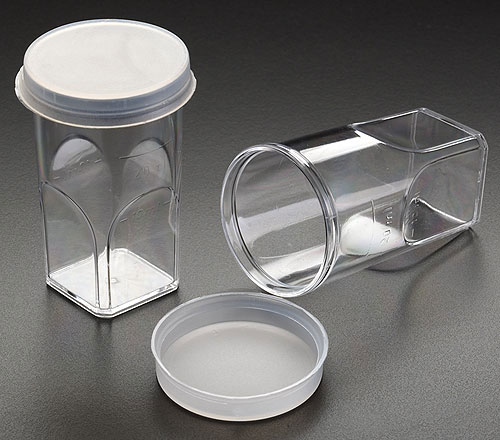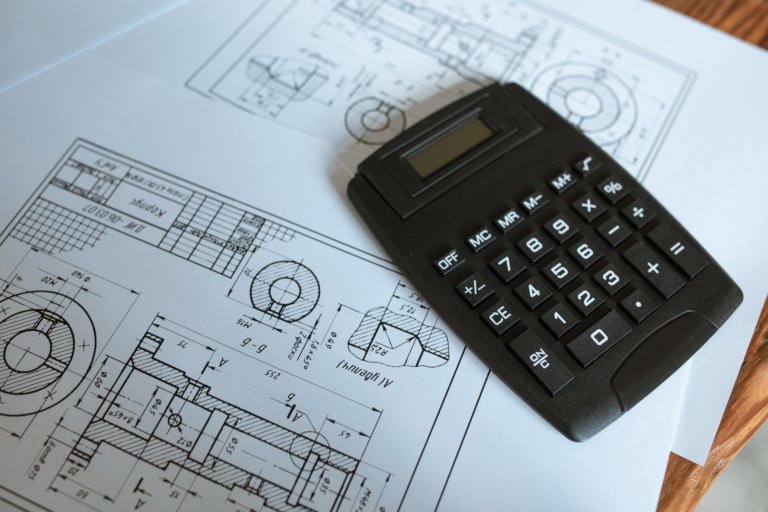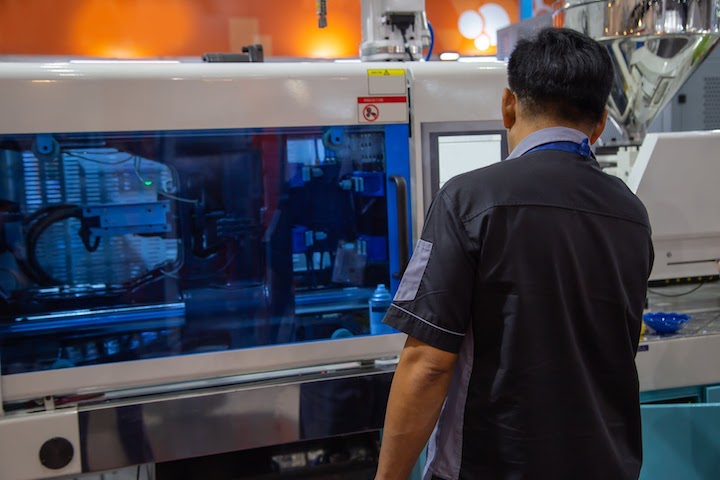Time to read: 5 min
Polystyrene (PS) is a commodity thermoplastic with an amorphous structure. It has excellent resistance to gamma rays and, therefore, supports sterilization by radiation. Polystyrene plastics can be either transparent or opaque, and unmodified polystyrene is clear, rigid, brittle and moderately strong. Also, polystyrene is cost-effective and supports injection molding.
Grades of polystyrene include GPPS and HIPS. General purpose polystyrene (GPPS) is naturally transparent and relatively brittle. High impact polystyrene (HIPS) contains additives that increase toughness but with a loss of transparency. When polystyrene is produced as a foam, types include extruded polystyrene (XPS) and expanded polystyrene (EPS).

Figure 1: Clear polystyrene is used in blood dilution lab vials. Image Credit: SKS Science
Advantages of Polystyrene Injection Molding
Polystyrene has a number of advantages that make it an ideal material for applications ranging from injection molded automotive parts to medical products. This thermoplastic has the following characteristics:
- Transparent
- Tough and rigid
- Lightweight
- Moisture resistant
- Impact resistant
- Dimensionally stable
- Radiation resistant
Transparent
In its pure form (GPPS), polystyrene is transparent with 90% light transmissibility. It provides a relatively inexpensive alternative to other transparent plastics, such as polycarbonate or acrylic. GPPS can be brittle, however, and that’s why HIPS is sometimes used instead.
Tough and Rigid
HIPS polystyrene contains between 5% and 10% butadiene rubber so that it’s tougher and more rigid. Applications include automotive instrument panels and computer housings.
Lightweight
Polystyrene is a lightweight plastic, which is why it’s often used in food containers, consumer packaging, and even ceiling-mounted smoke detectors.
Moisture Resistant
Polystyrene is highly resistant to moisture, which makes it a good choice for plastic cutlery, and laboratory and scientific products such as test tubes and petri dishes.
Impact Resistant
Although GPPS has relatively low impact strength, HIPS is strong enough to be used for protective packaging and in repeated-use applications such as cafeteria food trays.
Dimensionally Stable
Injected molded polystyrene has excellent dimensional stability. This is due, in part, to its amorphous nature, which reduces shrinkage after injection molding. Also, because polystyrene doesn’t absorb water, it won’t swell and increase in size.
Radiation Resistant
Polystyrene has a kilogray (kGy) value of 10,000, which means it absorbs very little radiation. This radiation resistance is due to the benzene ring in polystyrene’s molecular formula. Consequently, polystyrene can be subjected to radiation for sterilization purposes and won’t suffer a significant degradation of mechanical properties.

Polystyrene Injection Molding Design Guidelines
Polystyrene is relatively easy to injection mold, but it’s still important for part designers to follow guidelines in the following areas:
- Wall thickness
- Ribs & stiffeners
- Radii
- Draft angle
- Part tolerances
If you’re looking for more injection molding design tips and insights for polystyrene and a variety of other materials, download the Fictiv Injection Molding Design Guide.
Wall Thickness
Injection molded polystyrene should have a wall thickness between 0.76 and 5.1 mm. If the change between sections is gradual, a wall thickness variation of 25% can be achieved.
Ribs & Stiffeners
To prevent the formation of sink marks, make ribs 60% to 50% of the supported wall’s thickness.
Radii
The recommended radius depends on the type of polystyrene — because GPPS is more brittle than HIPS, a radius that’s too small is a potential source of failure. In general, a minimum radius of 25% of the wall thickness is recommended. For high-strength parts, use a radius of up to 75% instead.
Draft Angle
Polystyrene has a low shrinkage rate and is highly rigid. To ensure part ejection, apply draft angles between 0.5 and 1% and a polished finish to your molds to aid in part ejection.
Part Tolerances
Part tolerances can be either commercial or fine, with fine tolerances having tighter values. For example, a .125-inch-thick part that’s 1 inch long can be held to a commercial length tolerance of ±.003 in/in. A fine tolerance would be ±.002 in/in.Tighter tolerance requirements increase the cost of the mold and of injection molded parts, however.
Polystyrene Material Properties
Table 1 below lists some average physical, mechanical, and molding properties of various polystyrene injection molding grades:
| Unreinforced PS | Impact Modified PS | Transparent PS | Heat Resistant PS | ||
| Physical | Density (g/cm3) | 0.857 | 1.05 | 1.04 | 1.05 |
| Linear Mold Shrinkage Rate (cm/cm) | 0.00509 | 0.0060 | 0.00539 | 0.00557 | |
| Rockwell Hardness (R) | 100 | 94.8 | 121 | 105 | |
| Mechanical | Tensile Strength at Yield (MPa) | 43.7 | 25.9 | 43.6 | 45.9 |
| Elongation at break (%) | 25.8 | 44.8 | 3.14 | 9.74 | |
| Flexural Modulus (GPa) | 3.47 | 2.14 | 3.11 | 2.99 | |
| Flexural Yield Strength (MPa) | 69.2 | 54 | 76.2 | 82 | |
| Injection Molding | Drying Temperature (°C) | 92.2 | 78 | 76.7 | 76.2 |
| Melt Temperature (°C) | 250 | 216 | 220 | 215 | |
| Mold Temperature (°C) | 69.5 | 49.6 | 52 | 52.9 |
Table 1: Polystyrene Material Properties

Polystyrene Material Processing
Plastic injection molding with polystyrene successfully requires choosing the right processing parameters. Here are some of the most important ones to consider:
- Injection pressure
- Moisture resistance
- Temperature control
- Viscosity
- Shrinkage
Injection Pressure
Injection pressures for polystyrene can range from 100 to 200 Bar, and maintaining the pressure after injection can reduce overall shrinkage rates.
Moisture Resistance
Polystyrene resists moisture and generally does not need to be dried prior to molding. However, in cases where the resin may contain recycled material, or if the environment has high humidity, then pre-drying is recommended.
Temperature Control
Polystyrene has a relatively high melting point of around 217°C, depending on the material grade. This is higher than other common injection molding plastics, such as polyethylene. Despite its high melting temperature, polystyrene begins to soften between 70°C and 106°C.
Increased temperature may improve moldability, but can have a negative effect on glossiness and material strength. In addition, higher temperatures result in longer cycle times since molded parts need more time to cool before ejection. For best results, keep temperatures below 250°C.
Viscosity
Polystyrene has a low viscosity. This makes it ideal for injection molded parts with small features since material moves more easily throughout the mold. Different grades of polystyrene have different viscosities, however, and temperatures should be adjusted accordingly.
Shrinkage
Injection molded polystyrene has low shrinkage values, typically between 0.4% and 0.7%. In some cases, however, it’s possible to achieve shrinkage less than 0.4%, such as near the sprue where there are high follow-up pressures. Only 10% of total shrinkage occurs after part ejection.
Succeeding With Polystyrene Injection Molding
Polystyrene is used in a wide range of applications because this injection molding material is lightweight, relatively inexpensive, and moisture resistant. Provided that proper part design and processing guidelines are followed, PS is relatively easy to injection mold.
Polystyrene is a commonly used injection molding plastic, but a good plan and skilled production partner are critical to avoid the added costs and risks that come with inadequate drying or improper processing methods. Fictiv has the global manufacturing network and production experts you need to get quality injection molded parts, no matter how complex your designs. And we have the skills and know-how to support you from part design through prototyping and production.
Create your free Fictiv account and request an injection molding quote today — we mold complex parts at ridiculous speeds!










